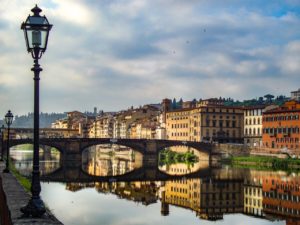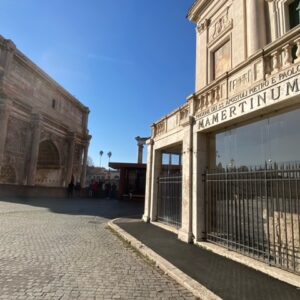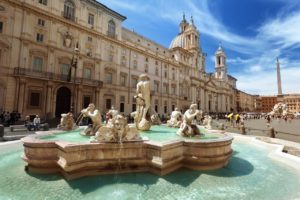St. Patrick’s well, situated in Umbria’s village Orvieto (central Italy), was commissioned by Pope Clement VII to architect Antonio da Sangallo the Younger in 1527, to be used to provide water in case of a siege, after the sack of Rome by the Holy Roman Emperor Carl V.
The history of St. Patrick’s well
It took the architect 10 years to build the cavity, which was completed during the popedom of Pope Paul III. Antonio, inspired by the spiral staircase of Vatican’s Belvedere Villa, built around the central well shaft two helical ramps to make the process of carrying water easier. That way one ramp could be used to transport full vessels and the other one to transport empty vessels, and the mules wouldn’t bump into each other during the process.
At the bottom, thanks to an emissary that drains excess water, the level is kept constant and there’s never a possibility of overflowing.
The external part is a low cylinder with Pope Paul III’s farnesian lilies used as a decoration.
At the entrance of the well you can find a Latin inscription that states “QUOD NATURA MUNIMENTO INVIDERAT INDUSTRIA ADIECIT”, which means “what nature stinted for provision, industry has supplied” and celebrates the human intellect and ability to overcome shortcomings of nature.
Benvenuto Cellini, as commissioned by Pope Clement VII, in honor of the construction of the cavity, minted a coin -now kept in the Vatican Museums-, on which there’s an image of Moses with a stick that pierces a rock, making the water flow in front of the Jews.
The medieval legend: the well as a symbol of Purgatory
There was a medieval legend that said that in Ireland you could reach the afterlife in correspondence to a bottomless cave, which symbolized Purgatory. It was believed that you could reach the bottom of it, which represented Paradise, only after facing a series of terrible trials to cleanse yourself of your sins.
What gave the cave the name “St. Patrick’s Purgatory” was the fact that St. Patrick used to retire in prayer next to it.
The well in Orvieto received the same destiny, being used to purify one’s sins and that’s why it was named after the Irish cave.
Its name is also used in the saying “it’s like St. Patrick’s well”, to indicate something in which you invest time, energy and resources without getting any result or ever seeing the end of it.
Orvieto is not only St. Patrick’s town, but it’s also famous for its precious-marbles-covered cathedral, in which you can find the Corporal of Bolsena!
Orvieto: a charming medieval village in central Italy worth visiting!














